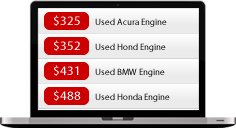Dodge Neon Engine
Please complete the following fields to receive bids from vendors with a Dodge Neon Engine for sale!
The Dodge Neon was produced from 1995 to 2005. The engine size has remained consistent throughout that period, measuring at 2.0L for each year. The 2005 release of this car has an inline four engine, which means the car has a somewhat simpler mechanical design, and it also has an engine with greater balance than other types of engines. This kind of engine causes small vibrations during operation. The engine is front-mounted and has a single overhead cam. In most instances, the single overhead cam (SOHC) provides slightly less power than the increasingly more common double overhead cam (DOHC) feature. However, the 2005 Dodge Neon does have four cylinders per valve, so it is possible to get enough air into the valves to give the car decent power.
Popular Dodge Neon Engines
| Year | Model | Body type | Engine Type | |
|---|---|---|---|---|
| 2005 | Neon | Sedan | 2.0L 4-cyl. 5-speed Manual | Get Quote |
| 2005 | Neon | Sedan | 2.4L 4-cyl. Turbo 5-speed Manual | Get Quote |
| 2004 | Neon | Sedan | 2.0L 4-cyl. 5-speed Manual | Get Quote |
| 2004 | Neon | Sedan | 2.0L 4-cyl. 4-speed Automatic | Get Quote |
| 2004 | Neon | Sedan | 2.4L 4-cyl. Turbo 5-speed Manual | Get Quote |
| 2003 | Neon | Sedan | 2.0L 4-cyl. 5-speed Manual | Get Quote |
| 2003 | Neon | Sedan | 2.4L 4-cyl. Turbo 5-speed Manual | Get Quote |
| 2002 | Neon | Sedan | 2.0L 4-cyl. 5-speed Manual | Get Quote |
| 2001 | Neon | Sedan | 2.0L 4-cyl. 5-speed Manual | Get Quote |
| 2000 | Neon | Sedan | 2.0L 4-cyl. 5-speed Manual | Get Quote |
| 1999 | Neon | Sedan | 2.0L 4-cyl. 5-speed Manual | Get Quote |
| 1999 | Neon | Coupe | 2.0L 4-cyl. 5-speed Manual | Get Quote |
| 1998 | Neon | Coupe | 2.0L 4-cyl. 5-speed Manual | Get Quote |
| 1998 | Neon | Sedan | 2.0L 4-cyl. 5-speed Manual | Get Quote |
| 1997 | Neon | Coupe | 2.0L 4-cyl. 5-speed Manual | Get Quote |
| 1997 | Neon | Sedan | 2.0L 4-cyl. 5-speed Manual | Get Quote |
| 1996 | Neon | Coupe | 2.0L 4-cyl. 5-speed Manual | Get Quote |
| 1996 | Neon | Sedan | 2.0L 4-cyl. 5-speed Manual | Get Quote |
| 1995 | Neon | Sedan | 2.0L 4-cyl. 5-speed Manual | Get Quote |
| 1995 | Neon | Coupe | 2.0L 4-cyl. 5-speed Manual | Get Quote |
This generation of the Dodge Neon has a 9.3 compression ratio, which is considered low by most standards. This ratio means that the exhaust emitted from the Neon is of a relatively higher than average temperature. The shorter cycle of expansion of the engine means that there less energy can be used from the same mass of air and fuel that automobiles with higher compression ratios allow. But the car is able to take fuels that are lower in octane without it causing a problem with engine life. Unlike cars with higher ratios, engine detonation from lower octane fuels is not an issue.
With an 87.5mm bore and an 83mm stroke, the engine in the 2005 Dodge Neon is oversquare. These engine designs are built for increased power and increased speed. When at lowered speeds, however, the power to these engines decreases. The amount of torque also decreases at reduced speeds.
For the most part, the design of the Dodge Neons throughout their releases has remained similar, though the 2001 Neon’s compression ratio of 9.8 is higher than that of later releases. This generation would be slightly more thermally efficient than releases with lower ratios. This is ratio of compression is also found on the 1995, 1996 and 1997 releases. The 1999 Dodge Neon also has a somewhat higher ratio, at 9.6.



